Sea Grant has released an Oil Spill Science Outreach publication discussing clean-up tools and techniques and decision-making factors related to oil spill response.
The bulletin is found here

Sea Grant has released an Oil Spill Science Outreach publication discussing clean-up tools and techniques and decision-making factors related to oil spill response.
The bulletin is found here
LBL Beacon Recovery Release
Middle School Student Anja Diercks learns about acoustic release operation to recover a Long Base Line (LBL) acoustic beacon after a successful AUV dive. These LBL beacons are necessary in aiding the Inertial Navigation System of the AUV while on survey on the ocean floor, sometimes at depths of 1600 m or more.
LBL Beacon Recovery
Middle School Student Anja Diercks helps recover the acoustic LBL (Long Base Line) beacon she had released from the ocean floor using an acoustic telemetry system minutes before. The Gulf of Mexico had a surprise for her too.
Fiberoptic Multicorer
Watch this successful collection of deep sea sediment cores during 7+ foot waves on a recent research cruise in the Gulf of Mexico. The Science team from National Institute for Undersea Science and Technology and Mississippi Mineral Resources Institute deployed a deep sea multicoring device in 1200 meters of water depth, attached to a fiberoptic winch cable. On the coring rig, they mounted several cameras and light sources. This spectacular mission was accomplished aboard the RV Pelican, during a recent research conducted for ECOGIG.
Credits: Diercks, A.; National Institute for Undersea Science and Technology (NIUST), Mississippi Mineral Resources Institute (MMRI) Ecosystem Impacts of Oil & Gas Inputs to the Gulf (ECOGIG) and Gulf of Mexico Research Institute (GOMRI).
Gary Finch Outdoors produced a series of videos highlighting various aspects of the Ecosystem Impacts of Oil and Gas Inputs to the Gulf (ECOGIG) program, its science, and the important partnerships necessary to make ECOGIG successful. Many of these videos were used by local PBS affiliates in Gulf coast states and were available through the ECOGIG website and YouTube. All videos listed below were developed and produced by Finch Productions, LLC.
What Does ECOGIG Do? (PBS Part 1) (2:20)
Scientists aboard the research vessels R/V Endeavor and E/V Nautilus briefly describe the nature of ECOGIG research.
Collaboration Between Nautilus and Endeavor Tour (PBS Part 2) (2:06)
ECOGIG scientists discuss the research they are conducting on a recent cruise aboard the R/V Nautilus and E/V Endeavor.
ECOGIG R/V Atlantis/ALVIN Cruise: March 30-April 23, 2014 (2:00)
Researchers describe the crucial importance of ALVIN dives in assessing the ecosystem impacts of the Deepwater Horizon explosion.
Deep Sea Life: Corals, Fish, and Invertebrates (4:30)
Dr. Chuck Fisher describes his research examining the fascinating and long-lived deep sea corals impacted by effects of the Deepwater Horizon explosion.
The Eagle Ray Autonomous Underwater Vehicle (AUV) News Piece (5:12)
ECOGIG scientists use the Eagle Ray AUV (autonomous underwater vehicle) to map the seafloor and get visuals so they can better target their sample collecting for study. The National Institute for Undersea Science and Technology (NIUST) provides the submersible.
(Full Length)
(Shortened News Piece)
Food Webs in the Gulf of Mexico (4:30)
ECOGIG scientists Jeff Chanton and Ian MacDonald, both of Florida State University, explain their complementary work exploring the possibility that hydrocarbons from oil have moved into the Gulf food web. Chanton, a chemical oceanographer, tells of a small but statistically significant rise in fossil carbon, a petrochemical byproduct of oil, showing up in marine organisms sampled from Louisiana to Florida. In addition to the hypothesis that Deepwater Horizon oil might be the culprit, biological oceanographer MacDonald discusses other factors that could also be at play, including coastal marsh erosion, natural oil seeps, and chronic oil industry pollution. This is a Finch Productions, LLC video. For more information, visit ECOGIG.ORG. https://ecogig.org/
Landers Technology Development (4:30)
Most of the area around the Deepwater Horizon spill ranges from 900 – 2000 meters below the surface of the Gulf of Mexico. ECOGIG scientists Dr. Chris Martens and Dr. Geoff Wheat talk about Landers, a new technology developed at the University of Mississippi that allows scientists to study the ocean floor at great depths. Landers are platforms custom-equipped with research instruments that can be dropped to the exact site scientists want to study and left for weeks, months, or even years to collect ongoing data.
Marine Snow (4:30)
Dr. Uta Passow describes research she and her colleagues Dr. Arne Dierks and Dr. Vernon Asper conduct on Marine Snow in the Gulf of Mexico. Oil released in 2010 from the Deepwater Horizon explosion floated upwards. Some of this oil then sank towards the seafloor as part of marine snow. When marine snow sinks, it transports microscopic algae and other particles from the sunlit surface ocean to the dark deep ocean, where animals rely on marine snow for food.
Natural Seeps – Geology of the Gulf (4:30)
ECOGIG Scientists Dr. Joe Montoya, Dr. Andreas Teske, Dr. Samantha Joye, and Dr. Ian McDonald describe their collaborative research approach while preparing for the Spring 2014 cruise aboard the R/V Atlantis with research sub ALVIN. Long-term sampling and monitoring of natural oil seeps in the Gulf of Mexico, a global hot spot for these seeps, is crucial for understanding the impacts of oil and gas from explosions like Deepwater Horizon.
Remote Sensing & Modeling (4:30)
ECOGIG scientists Dr. Ian MacDonald and Dr. Ajit Subramaniam describe their work monitoring the health of the Gulf of Mexico via remote sensing. Using images from satellites and small aircraft flown by volunteers, MacDonald looks for signs of surface oil, which could be the result of a natural seep, anthropogenic seeps (chronic oil leaks from ongoing drilling operations), or a larger spill like Deepwater Horizon. Subramaniam uses the changes in light in these images to help him understand what is happening below the sea surface, with particular focus on the health of phytoplankton populations that make up the base of the marine food web. This is a Finch Productions, LLC video with additional footage provided by Wings of Care, a nonprofit that assists with volunteer filming operations.
ROVs in STEM Education News Piece (4:30)
ECOGIG’s Dr. Chuck Fisher describes the use of ROVs in researching deep -sea corals in the Gulf of Mexico, and Ocean Exploration Trust’s Dr. Bob Ballard explains the powerful impacts of ROVs in STEM education, as shown during a recent visit onboard the EV Nautilus by members of the Girls and Boys Club of the Gulf region.
(Full Length)
(Shortened News Piece)
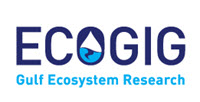
This series of videos entitled “What’s That?” to explain the oceanography techniques that researchers use to collect data in the Gulf of Mexico.
Videos in the series may be viewed in any order and include the videos below:
Lamont Oceanographic Biochemical Observer (LOBO)
Nitrogen and Carbon Fixation Methods
Phosphorus and Nitrogen Filtration Methods
Sampling the Water Column
Sediment Trap Deployment
Safety First!
These videos were developed to demonstrate research aboard the E/V Nautilus.
ECOGIG in 60 Seconds
Dr. Katy Croff Bell, Chief Scientist of the EV Nautilus crew, explains the mission of ECOGIG.
Imaging Deep-Water Corals (Nautilus Live)
As part of the ECOGIG project, the E/V Nautilus made its way to the site of the 2010 BP Deepwater Horizon oil spill to image affected corals. Using the ROV Hercules’ BEAST CAM, the scientists are able to capture extremely high resolution pictures. These pictures will be used to show change over time and growth rate.
ECOGIG and EV Nautilus Inspire Kids with ROVs
“It was really cool, because I want to be marine biologist when I grow older. So being able to see this and experience the boat and the submarines and how to work them and stuff like that, it was eye awakening. I really want to do this now.” As the Nautilus prepared to launch for a corals research cruise, led by Dr. Chuck Fisher, nearly 200-members of the Boys and Girls Clubs walked on deck to see how the remotely operated vehicles are used for deep sea research. They also built and tested their own miniature ROVs.

 The Loop podcast takes a deep dive into the Gulf of Mexico with the researchers studying the processes, mechanisms, and impacts of oil spills.
The Loop podcast takes a deep dive into the Gulf of Mexico with the researchers studying the processes, mechanisms, and impacts of oil spills.
Researchers from the Center for Integrated Modeling and Analysis of Gulf Ecosystems (C-IMAGE) discuss their studies with David Levin of Mind Open Media. C-IMAGE is an international research group studying mud, microbes and mammals after two mega spills, Deepwater Horizon and Ixtoc I. The goal of C-IMAGE is to advance understanding of the fundamental processes and mechanisms of marine blowouts and their consequences, ensuring that society is better-prepared to mitigate future events.
Episode 1: Overview of C-IMAGE
C-IMAGE PI Dr. Steven Murawski talks to David Levin about C-IMAGE’s research goals and the importance of integration when tackling large scale impacts. This episode is available in English and Spanish. (Transcript: English, Español)
Español:
Episode 2: The Mud and the Blood
C-IMAGE PIs Steven Murawski and David Hollander talk to David Levin aboard the R/V Weatherbird II in August 2012 about looking for Deepwater Horizon‘s impacts on Gulf of Mexico mud and fish. This episode is available in English and Spanish. (Transcript: English, Español)
Español:
Episode 3: The “Not-So-Visible” Impacts of the Deepwater Horizon Oil Spill on the Gulf of Mexico
Three years after the BP oil well disaster, scientists are struggling to understand the effects on the Gulf ecosystem. David Levin reports on the oil’s impact on the tiny creatures that form the base of the food chain. (Transcript: English)
Episode 4: Fitting the Gulf of Mexico Inside a Computer: How to Build an Ecosystem Model
David Levin talks with C-IMAGE members Cameron Ainsworth, Jason Lenes, Michelle Masi, and Brian Smith about building an ecosystem model of the Gulf of Mexico to describe how oil spills impact marine life. (Transcript: English, Español)
Episode 5: The Pressure is On!
David Levin talks with C-IMAGE PI Steven Murawski and scientists from the Technical University of Hamburg at Harburg Michael Schluter and Karen Malone about their ongoing experiments examining oil and gas droplets under high pressure to learn more about the Deepwater Horizon oil spill. (Transcript: English, Español)
Episode 6: Oil – It’s What’s for Dinner…
C-IMAGE scientists want to know more about how oil-eating microorganisms behave in the cold deep ocean to learn more about what happened to the oil from the Deepwater Horizon blowout. High-pressure experiments underway at our high pressure facility at the Hamburg University of Technology focus on how these microbes use oil and what happens to them in the process. Results from these studies may lead to a new way to clean up spills by eliminating its most poisonous ingredients. (Transcript: English, Español)
Episode 7: The Ixtoc Spill – Reflections
The Deepwater Horizon oil spill happened just a few years ago, but it might be possible to predict its impact on the Gulf by studying another major spill, one that happened in 1979. “These are two of the largest spills in the world’s history as far as blowouts go, and they were both in the Gulf of Mexico.” Wes Tunnell is a marine biologist who is looking at the aftermath of both spills. It’s almost like he’s looking at the same crime scene, separated by more than three decades. How? Give a listen. Mind Open Media producer David Levin talks to Wes Tunnell and John Farrington about their experiences during the 1979 Ixtoc spill and the applications to new blowouts thirty years late. This episode is available in English and Spanish. (Transcript: English, Español)
Español:
Episode 8: In the Mud in Mexico
“We were of the mind that with studying the Deepwater Horizon in the northern Gulf we weren’t getting a full Gulf of Mexico perspective.” Geochemist David Hollander is traveling with an international team of scientists aboard a Mexican research vessel. Over the last few years, his team has studied the effects of the 2010 Deepwater Horizon spill. But today, they’re looking back at a spill that happened 35 years ago and what they learn on this trip might help them understand the future of the Gulf. Mind Open Media producer David Levin talks to David Hollander, Joel Ortega Ortiz, Isabel Romero, Adriana Gaytán-Caballero, and Travis Washburn about their experiences on the RV Justo Sierra in the southern Gulf of Mexico during the research on the Ixtoc spill. (Transcript: English, Español)
Episode 9: Forensic Oceanography
Listen to learn how scientists reanalyzed remotely sensed data taken in the late 1970s to study the Ixtoc 1 oil spill. Dr. Chuanmin Hu and his graduate student Shaojie Sun use the Landsat and Coastal Zone Color Scanner (CZCS) data to develop “treasure maps” of oil from the IXTOC-1 spill to steer field studies. Listen in to find out how they did it. This episode is available in English and Spanish. (Transcript: English, Español)
Español:
Episode 10: The Risks for Fish
What happened to the fish in the days and weeks after the Deepwater Horizon oil spill? With a suite of exposure studies, C-IMAGE researchers are monitoring fish health after oil exposure in order to find out. Dr. Dana Wetzel and Kevan Main of Mote Marine Laboratory give fish a small does of oil through either their food, water, or the sea floor sediments, then analyze how their bodies recover. (Transcript: English, Español)
Episode 11: The Cuban Connection: Spills, Science Diplomacy
C-IMAGE collaborated with researchers from the University of Havana for the first join U.S.-Cuban expedition in over 50 years. (Transcript: English)
Episode 12: MTS TechSurge
When research and industry can communicate effectively when responding to an oil spill, both the environment and oil industry benefit from shared knowledge and new technologies. (Transcript: English)
Episode 13: For a Few Dollars More – Costs and Ecosystem Services after Spills
When oil spills are assessed through an economic viewpoint, both environmental and human impacts must be considered to provide a full picture. (Transcript: English)
Episode 14: Modeling Arctic Oil Spills
Understanding the long-term effects of arctic spills like this one could be even more urgent now than ever, as oil exploration makes its way to the North Slope of Alaska (including inside the Arctic National Wildlife Refuge). C-IMAGE has developed a computer model of the entire Gulf ecosystem, so they could test how future spills would affect the region. And now, they’re applying those tools farther north. (Transcript: English)
Episode 15: Asphalt Ecosystems
At the bottom of the Gulf of Mexico, some truly bizarre ecosystems are hiding in the darkness among the asphalt volcanoes and supporting huge colonies of unique life. C-IMAGE has been analyzing these ecosystems and reveals that if chemosynthetic communities are harmed, it could affect other environments as well. The microbes that power those communities don’t just eat chemicals in oil or asphalt—they also eat up a lot of free-floating carbon that would otherwise escape to the rest of the ocean… and eventually, get into the atmosphere, adding to global climate change. (Transcript: English)
Episode 16: Panel Discussion
For the past several years, The Loop covered the work of scientists studying the aftermath of the 2010 Deepwater Horizon oil spill. The research is winding down and this is The Loop‘s last podcast with C-IMAGE! (Transcript: English)
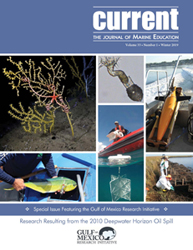 Outreach coordinators from Gulf of Mexico Research Initiative (GoMRI) consortia partnered to produce a special issue of Current: The Journal of Marine Education, published by the National Marine Educators Association (NMEA). The GoMRI-sponsored special issue – titled “Special Issue Featuring the Gulf of Mexico Research Initiative: Research Resulting from the 2010 Deepwater Horizon Oil Spill” – features synthesis articles on oil spill science and educational resources that educators can use to incorporate oil spill science into their curriculums. The goal of the issue is to convey the scientific process using the Deepwater Horizon oil spill and GoMRI as an example.
Outreach coordinators from Gulf of Mexico Research Initiative (GoMRI) consortia partnered to produce a special issue of Current: The Journal of Marine Education, published by the National Marine Educators Association (NMEA). The GoMRI-sponsored special issue – titled “Special Issue Featuring the Gulf of Mexico Research Initiative: Research Resulting from the 2010 Deepwater Horizon Oil Spill” – features synthesis articles on oil spill science and educational resources that educators can use to incorporate oil spill science into their curriculums. The goal of the issue is to convey the scientific process using the Deepwater Horizon oil spill and GoMRI as an example.
Click here for a free PDF copy of the issue (hosted with permission from NMEA).
The special issue includes:
Jessie Kastler (Consortium for Oil Spill Exposure Pathways in Coastal River-Dominated Ecosystems, CONCORDE), Katie Fillingham (GoMRI Management Team), Sara Beresford (Ecosystem Impacts of Oil and Gas Inputs to the Gulf consortium, ECOGIG), and Teresa Greely (Center for the Integrated Modeling and Analysis of the Gulf Ecosystem, C-IMAGE) served as co-editors and co-authors for the special issue.
Laura Bracken (Consortium for Advanced Research on Transport of Hydrocarbon in the Environment, CARTHE), Murt Conover (Coastal Waters Consortium, CWC), Emily Davenport (ECOGIG), Dan DiNicola (formerly Relationships of Effects of Cardiac Outcomes in Fish for Validation of Ecological Risk consortium, RECOVER), Sandra Ellis (GRIIDC) and Rachel McDonald (Alabama Center for Ecological Resilience, ACER) also served as co-authors.
Permission has been granted to the Gulf of Mexico Research Initiative (GoMRI) to reprint the special issue of Current: The Journal of Marine Education featuring the Gulf of Mexico Research Initiative (Vol. 33, No. 1, Winter 2019) published by the National Marine Educators Association (NMEA) ©2019. For more information about the NMEA, please visit www.marine-ed.org.
**********
The Gulf of Mexico Research Initiative (GoMRI) is a 10-year independent research program established to study the effect, and the potential associated impact, of hydrocarbon releases on the environment and public health, as well as to develop improved spill mitigation, oil detection, characterization and remediation technologies. An independent and academic 20-member Research Board makes the funding and research direction decisions to ensure the intellectual quality, effectiveness and academic independence of the GoMRI research. All research data, findings and publications will be made publicly available. The program was established through a $500 million financial commitment from BP. For more information, visit http://gulfresearchinitiative.org/.
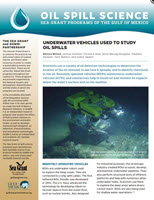
Have you ever wondered how scientists ‘see’ under water? The Gulf of Mexico Research Initiative is pleased to announce a new Sea Grant publication about the technology scientists use to look at and study the deep ocean, specifically manned and unmanned vehicles.
Scientists have used remotely operated vehicles (ROVs), autonomous underwater vehicles (AUVs), and submarines, including human-occupied vehicles, to locate Deepwater Horizon oil and monitor its impacts below the water’s surface and on the seafloor.
Read Underwater Vehicles Used to Study Oil Spills to learn about how these underwater robotic devices work and how researchers have used them in the Gulf of Mexico. Included is a chart that gives the cost of use, type of use, advantages, and disadvantages for each of these technologies.
Read more about recent deep ocean research:
The Sea Grant Oil Spill Outreach Team synthesizes peer-reviewed science for a broad range of general audiences, particularly those who live and work across the Gulf Coast. Sea Grant offers oil-spill related public seminars across the United States.
Information about upcoming Sea Grant science seminars and recently-held events is available here. To receive email updates about seminars, publications, and the outreach team, click here.
************
GoMRI and the Sea Grant programs of the Gulf of Mexico (Florida, Mississippi-Alabama, Louisiana, and Texas) have partnered to create an oil spill science outreach program.
The Gulf of Mexico Research Initiative (GoMRI) is a 10-year independent research program established to study the effect, and the potential associated impact, of hydrocarbon releases on the environment and public health, as well as to develop improved spill mitigation, oil detection, characterization and remediation technologies. An independent and academic 20-member Research Board makes the funding and research direction decisions to ensure the intellectual quality, effectiveness and academic independence of the GoMRI research. All research data, findings and publications will be made publicly available. The program was established through a $500 million financial commitment from BP. For more information, visit https://gulfresearchinitiative.org/.
© Copyright 2010- 2018 Gulf of Mexico Research Initiative (GoMRI) – All Rights Reserved. Redistribution is encouraged with acknowledgement to the Gulf of Mexico Research Initiative (GoMRI). Please credit images and/or videos as done in each article. Questions? Contact web-content editor Nilde “Maggie” Dannreuther, Northern Gulf Institute, Mississippi State University (maggied@ngi.msstate.edu).
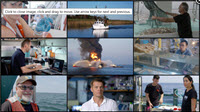
Screenscope, Inc., is pleased to announce the release of 50 short videos complementing the Dispatches from the Gulf documentary film.
The videos include highlights from the film, interviews with Gulf of Mexico Research Initiative (GoMRI)-funded scientists and graduate students, and more. An associated Educators Guide provides detailed descriptions and keywords for each video. The videos were generated as an extension of the film, to be used in classroom curriculum and in other educational efforts.
****************************
Dispatches from the Gulf is made possible in part by a grant from the Gulf of Mexico Research Initiative. The GoMRI is a 10-year independent research program established to study the effect, and the potential associated impact, of hydrocarbon releases on the environment and public health, as well as to develop improved spill mitigation, oil detection, characterization and remediation technologies. An independent and academic 20-member Research Board makes the funding and research direction decisions to ensure the intellectual quality, effectiveness and academic independence of the GoMRI research. All research data, findings and publications will be made publicly available. The program was established through a $500 million financial commitment from BP.
![]() The creators of award-winning environmental series Journey to Planet Earth (hosted by Matt Damon) present Dispatches from the Gulf – an upcoming documentary film and educational outreach initiative highlighting exclusive scientific discoveries in health, ecosystems, innovation and recovery in the post-oil spill Gulf of Mexico.
The creators of award-winning environmental series Journey to Planet Earth (hosted by Matt Damon) present Dispatches from the Gulf – an upcoming documentary film and educational outreach initiative highlighting exclusive scientific discoveries in health, ecosystems, innovation and recovery in the post-oil spill Gulf of Mexico.
Published on Jun 22, 2016
Six years after the Deepwater Horizon blowout, an international team of researchers is focused on the Gulf of Mexico. These are some of their stories – intimate portraits of research – innovation – discovery. Stories that speak directly to a nation still recovering from the largest oil spill in U.S. history.
Share your thoughts at the following Dispatches from the Gulf Social Media links:
++++++++++++++++++++++++++++++++++
“Dispatches from the Gulf” is a new Journey to Planet Earth (J2PE) episode showing how scientists confront the challenges of the Deepwater Horizon oil spill. The documentary also investigates the impact of the event on the ecosystems and communities along the Gulf of Mexico.
J2PE dramatizes new ways of looking at the delicate relationship between people and the world they inhabit. The series is designed to help viewers understand and cope with the most important environmental issues of the 21st century.
Through an interdisciplinary approach, these programs reach beyond the physical sciences and draw connections to politics, economics, sociology, and history. A common thread runs throughout — the necessity to achieve a balance between the needs of people and the needs of the environment. Though photographed on different continents and focusing on different sets of problems, audiences come to see why all of these stories are connected, providing a dramatic mosaic of how the Earth works as an interrelated system.
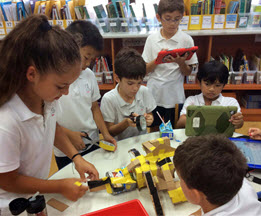
Students construct their own drifter after being inspired by “Bob the Drifter”. (Provided by: Jenny Harter)
Communicating oil spill research is essential to improve society’s understanding about spills and their ability to respond to and mitigate them.
The Gulf of Mexico Research Initiative (GoMRI) has been funding spill-related research since 2010.
Here are ten outstanding education products and resources that GoMRI and its science community have developed to share what they are learning, doing, and how they are preparing the next generation of scientists for future spill research.
Products You Can Watch…
“Film provides an opportunity to marry the power of ideas with the power of images.”
— Steven Bochco, television writer and producer
Products You Can Hear…
“Storytelling is the most powerful way to put ideas into the world today.”
— Robert McKee, writer
The Pressure Is On: In “Under Pressure”, German scientists modeled the Deepwater Horizon blowout in a tank that can simulate the water pressure level of the blowout depth to track the oil’s movement and better understand oil dynamics at extreme depths.
“Under Pressure” (07:43):
Seeking New Insights from Decades-Old Spill: In “The Gulf’s Big Blowouts” and “Return to Ixtoc”, an international team of researchers hoping to predict how Deepwater Horizon may impact the Gulf decades into the future set out to study a spill of the past – the 1979 Ixtoc I blowout.
“The Gulf’s Big Blowouts” (08:08):
“Return to Ixtoc” (9:03):
Products for the Classroom…
“The one exclusive sign of thorough knowledge is the power of teaching.”
— Aristotle
Products You Can Explore…
“The real voyage of discovery consists not in seeking new landscapes, but in having new eyes.”
— Marcel Proust, novelist
************
This research was made possible in part by a grant from the Gulf of Mexico Research Initiative (GoMRI) to theConsortium for Advanced Research on Transport of Hydrocarbon in the Environment (CARTHE), Ecosystem Impacts of Oil and Gas Inputs to the Gulf (ECOGIG) Consortium, the Center for Integrated Modeling and Analysis of Gulf Ecosystems (C-IMAGE I and C-IMAGE II), the Deepsea to Coast Connectivity in the Eastern Gulf of Mexico (Deep-C)Consortium, the Deep-Pelagic Nekton Dynamics of the Gulf of Mexico (DEEPEND) Consortium, and the Coastal Waters Consortium (CWC).
Dispatches from the Gulf is made possible in part by a grant from the Gulf of Mexico Research Initiative (GoMRI).
GoMRI and the Sea Grant programs of the Gulf of Mexico (Florida, Mississippi-Alabama, Louisiana, and Texas) have partnered to create an oil spill science outreach program.
GoMRI and the Smithsonian have a partnership to enhance oil spill science content on the Ocean Portal website.
The GoMRI is a 10-year independent research program established to study the effect, and the potential associated impact, of hydrocarbon releases on the environment and public health, as well as to develop improved spill mitigation, oil detection, characterization and remediation technologies. An independent and academic 20-member Research Board makes the funding and research direction decisions to ensure the intellectual quality, effectiveness and academic independence of the GoMRI research. All research data, findings and publications will be made publicly available. The program was established through a $500 million financial commitment from BP. For more information, visithttp://gulfresearchinitiative.org/.
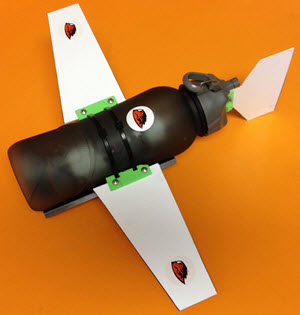
Photo and Story Credit: LADC-GEMM
The research and science behind projects like Littoral Acoustic Demonstration Center – Gulf Ecological Monitoring and Modeling (LADC-GEMM) can often seem high-brow, inaccessible, and even confusing. So, one of the ways the LADC-GEMM project aims to demystify ocean science is by using the popularity of robotic ocean gliders – like our charismatic “Otis” and “Clyde” – to engage teachers and students in exploring many of the essential skills and principles of the kind of work that is becoming more commonplace in the marine sector.
“What are underwater gliders and how are they used by scientists to study the ocean and its inhabitants?” is a simple question that opens up many avenues for exploration. But the most fun and accessible is actually building a working model of a seaglider. Recently, 20 elementary through high school, in and out-of-school, educators from around the state of Oregon came to the Hatfield Marine Science Center in Newport, Oregon to spend a Saturday doing just that. During the SeaGlide Educator Workshop, they also heard directly from LADC-GEMM scientists how gliders are being used in their research and were treated to a presentation by Toledo, Oregon, high school students who had already spent a school term building their own simple versions and analyzing real data collected by gliders used in recent field work. This gave the workshop participants the opportunity to see how curricula can be developed around this engaging STEM activity, either in a classroom or for after-school programs.
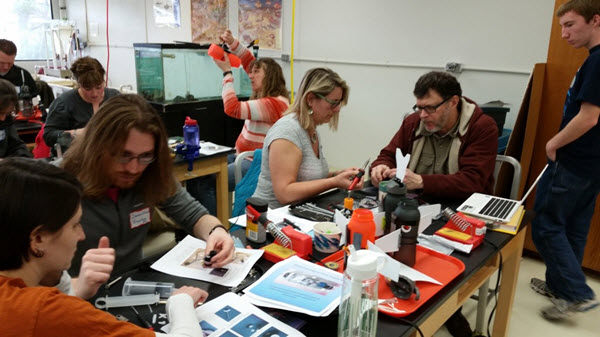
Photo Credit: LADC-GEMM
The seagliders built during the workshop used designs and instructions developed by Michael Britt-Crane at Seaglide.net. SeaGlide was originally designed for high school students. It moves by changing its buoyancy, taking in or expelling water. This change in buoyancy causes the glider to rise and sink in the water. As the glider travels up and down, its wings generate lift, which propels the glider forward. SeaGlide can’t run for months at a time like real gliders, but it can collect temperature and pressure data as it ‘flies’ through the water.
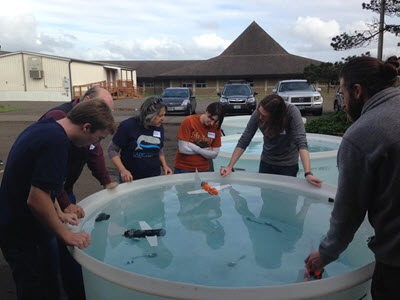
Photo Credit: LADC-GEMM
For the workshop participants, the hands-on experience of building their own Seaglider with the help of mentors (several were local members of the high school robotics club) proved to be the most valuable part of the day. The majority walked away from the workshop feeling confident in facilitating this STEM learning experience, and being able to teach students about the science, technology, engineering and math aspects. Some plan to incorporate gliders in curriculum as part of a course in the school system, some in an after school club or activity, and a few as a summer program.
Here at LADC-GEMM, we can’t wait to hear how these educators apply their new skills and implement their SeaGlide programs.
SeaGlide workshops are being organized by LADC-GEMM consortium members for 2016 and 2017, in Mississippi and other “Gulf States”. Look for the announcements on this website!
Click here for more details about this workshop
Click here for resources useful for outreach program development
Click here for more information about the Oregon Coast STEM Hub
 Screenscope, Inc. has completed production of three Dispatches from the Gulf documentary films, which features scientists working to better understand the effects of the Deepwater Horizon oil spill. Dispatches from the Gulf is part of the Journey to Planet Earth series and is narrated by Matt Damon.
Screenscope, Inc. has completed production of three Dispatches from the Gulf documentary films, which features scientists working to better understand the effects of the Deepwater Horizon oil spill. Dispatches from the Gulf is part of the Journey to Planet Earth series and is narrated by Matt Damon.
All three films and corresponding educational materials are available to watch for free below. They are also available (along with 50 short videos designed to accompany the documentaries) on the Dispatches from the Gulf YouTube Channel. Major funding for these additions to Journey to Planet Earth was provided by the Gulf of Mexico Research Initiative – scientists working together to understand and restore the health of marine and coastal ecosystems.
Dispatches from the Gulf:
In the years after Deepwater Horizon, a global team of scientists investigates the environmental health of the Gulf and its impact on local communities. A coalition of academic institutions, government, and NGOs are working together to protect and restore one of our planet’s most valuable natural resources. Their ultimate goal is to learn how to cope with future oil spills.
Educational Materials:
Dispatches from the Gulf 2:
The unprecedented scientific mission to study the lasting impacts of Deepwater Horizon continues. Barely half of the pre-spill dolphin population survives, their calves dying or miscarried. Fish hearts cannot beat properly. Crab burrows leak oily rivulets into wetlands poisoning fish nurseries. Will this ecosystem recover? Will we be able to prevent future oil spills and the ensuing environmental devastation?
Educational Materials:
Dispatches from the Gulf 3:
“Has the Gulf of Mexico recovered from the Deepwater Horizon oil spill?” As the tenth anniversary of the disaster approaches, this question is regularly posed. Scientists have spent nearly that long studying its environmental impact on humans, wildlife, and the ecosystem. They provide assessments of the current state of the Gulf, but lingering questions are challenging their ability to predict the long-term impacts.
Educational Materials:
 The Deepwater Horizon oil spill initiated an unprecedented response effort and mobilized the largest, coordinated scientific research endeavor around an ocean-related event in history; the Gulf of Mexico Research Initiative (GoMRI).
The Deepwater Horizon oil spill initiated an unprecedented response effort and mobilized the largest, coordinated scientific research endeavor around an ocean-related event in history; the Gulf of Mexico Research Initiative (GoMRI).
The Screenscope film production company is developing “Dispatches from the Gulf” to help tell the story about the scientists involved and their research to improve society’s ability to understand, respond to, and mitigate the impacts of petroleum pollution and related stressors of the marine and coastal ecosystems. The movie will air later this year as a new episode of the award-winning Journey to Planet Earth Series.
For additional information about the Gulf of Mexico Research Initiative:
“Dispatches from the Gulf” is made possible in part by a grant from The Gulf of Mexico Research Initiative (GoMRI). TheGoMRI is a 10-year independent research program established to study the effect, and the potential associated impact, of hydrocarbon releases on the environment and public health, as well as to develop improved spill mitigation, oil detection, characterization and remediation technologies. An independent and academic 20-member Research Board makes the funding and research direction decisions to ensure the intellectual quality, effectiveness and academic independence of the GoMRI research. All research data, findings and publications will be made publicly available. The program was established through a $500 million financial commitment from BP. For more information, visit http://gulfresearchinitiative.org/.